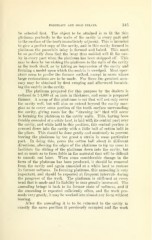Page 687 - My FlipBook
P. 687
POBCELAIN AND GOLD INLAYS. 345
be selected first. The object to be attained is to fit the thin
platinum perfectly to the walls of the cavity in every part and
to the surface of the tooth immediately adjacent. This is intended
to give a perfect copy of the cavity, and in this cavity formed in
platinum the porcelain inlay is formed and baked. This must
be so perfectly done that the inlay thus molded will fit the cav-
ity in every jaart when the platinum has been stripped off. This
may be done by burnishing the platinum to the walls of the cavity
in the tooth itself, or by taking an imiDression of the cavity and
forming a model upon which the matrix is swedged. Most oper-
ators seem to prefer the former method, except in cases where
large restorations are to be made. For these the greatest accu-
racy may be obtained by first swaging and afterward burnish-
ing the matrix in the cavity.
The platiniun prepared for this purpose by the dealers is
reduced to 1-1,000 of an inch in thickness, and some is prepared
thinner. A scrap of this platiniun is cut that will not only cover
the cavity well, but will also so extend beyond the cavity mar-
gins as to cover some portion of the tooth surface surrounding
the cavity, giving room' for the "drawing in" that will occur
in fonning the platinum to the cavity walls. This, having been
freshly annealed at a ivhite heat, is laid with its central part over
the cavity, and while held in this position, this central portion is
pressed down into the cavity with a little ball of cotton held in
the pliers. This should be done gently and cautiously to prevent
tearing the platinum by too great a strain in some particular
part. In doing this, press the cotton ball about in different
directions, allowing the edges of the platiniun to tip up some to
facilitate the sliding of the platinum down into the cavity, but
not so much as to form folds in the material that will be difficult
to smooth out later. When some considerable change in the
form of the platinum has been produced, it should be removed
from the cavity and again annealed at a white heat to restore
its former softness. In forming platinum, this annealing is very
important, and should be repeated at frequent intervals during
the progress of the work. The platinum is stiffened at every
bend that is made and its liability to tear greatly increased. The
annealing brings it back to its former state of softness, and if
the annealing is repeated sufficiently often, and the work pro-
ceeds very gently, it may be worked into almost any form without
tearing.
After the annealing it is to be returned to the cavity in
exactly the same position it previously occupied and the work


